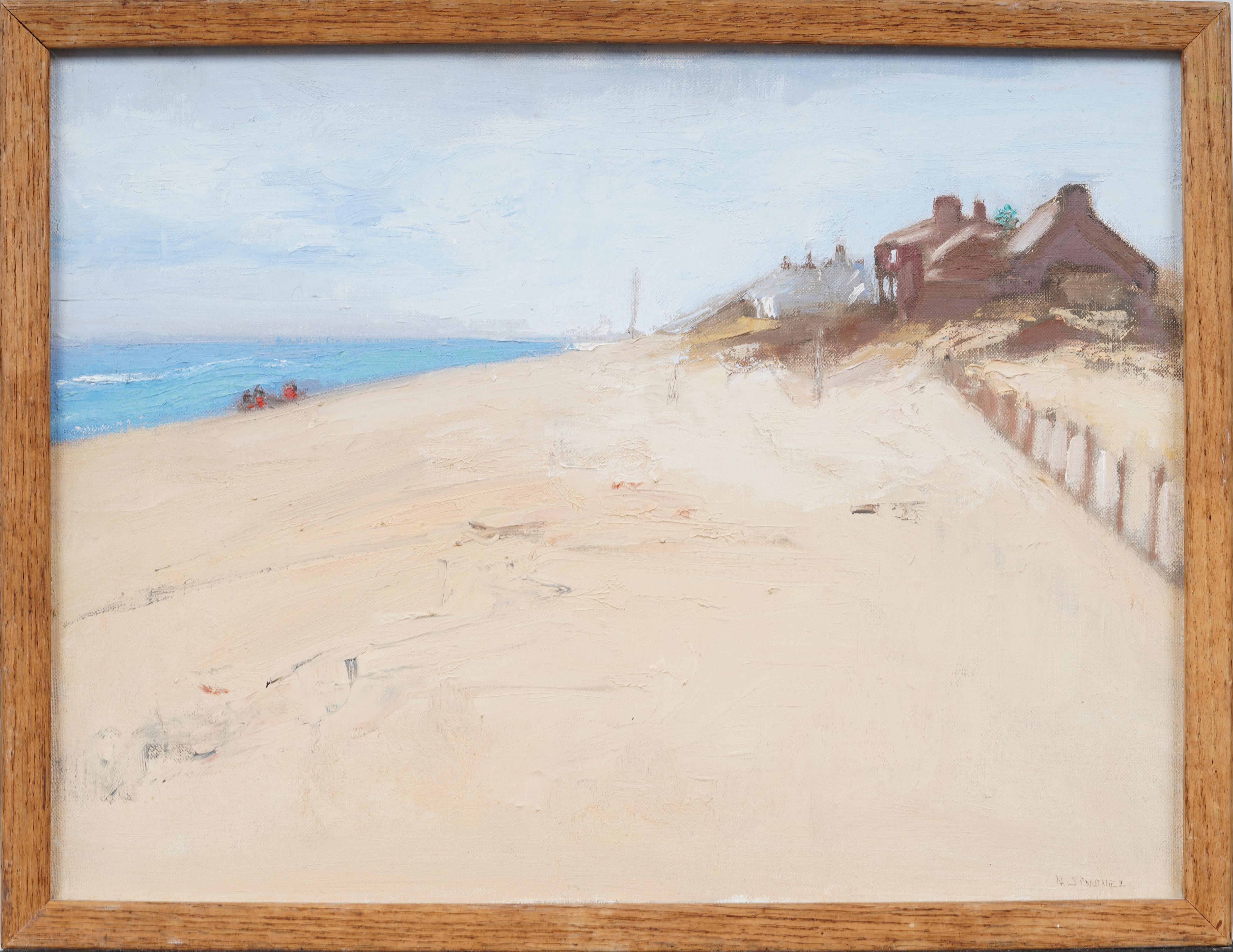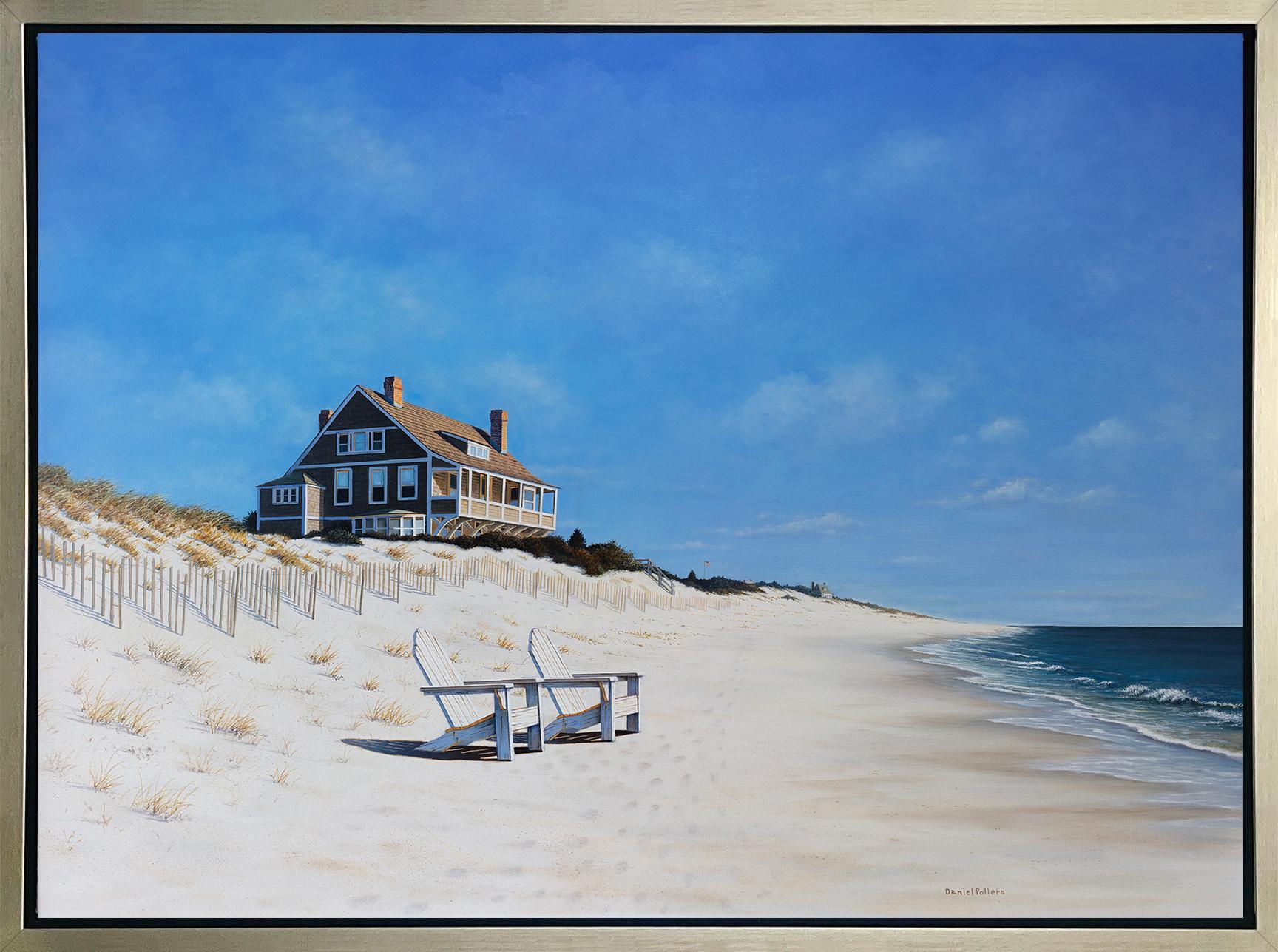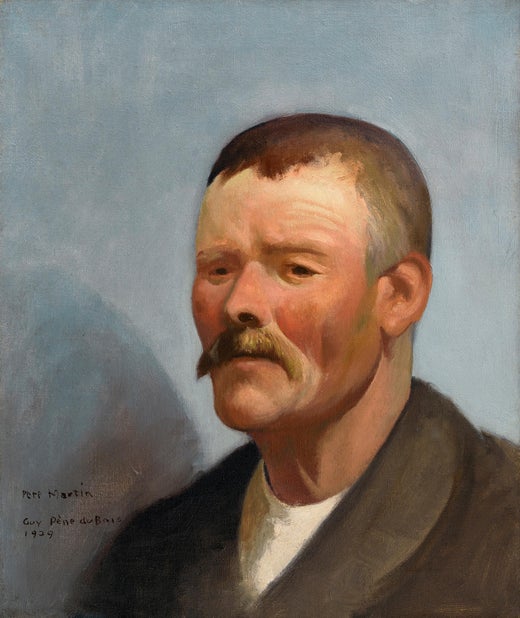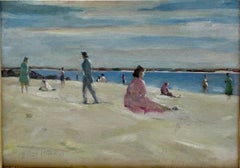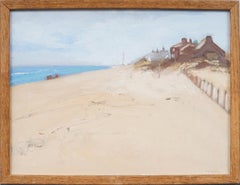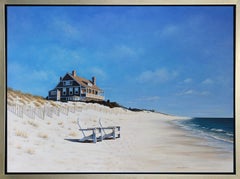Items Similar to "Seaside (Amagansett Beach)" Guy Pène du Bois, American Realist Beach Scene
Want more images or videos?
Request additional images or videos from the seller
1 of 10
Guy Pène Du Bois"Seaside (Amagansett Beach)" Guy Pène du Bois, American Realist Beach Scene1939
1939
$12,000
£9,049.19
€10,465.82
CA$16,835.94
A$18,714.19
CHF 9,809.58
MX$228,545.52
NOK 122,466.90
SEK 115,218.51
DKK 78,113.87
About the Item
Guy Pene du Bois
Seaside (Amagansett Beach), 1939
Signed and dated lower left; artist label on the reverse: "Seaside CAT No 192"
Oil on canvas
16 x 20 inches
Pène du Bois descended from French immigrants who settled in Louisiana in 1738 and was raised in a Creole household. He was born in 1984 in Brooklyn, NY and first studied with William Merritt Chase at the New York School of Art and later continued his training with Robert Henri. Pène du Bois was greatly impressed with Henri's credo that "real life" was subject matter for art and throughout his life a realist philosophy informed his art as well as his parallel career, art criticism. In 1905, Pène du Bois made his first visit to Paris where he painted scenes of fashionable people in cafes rendered in the dark tonalities and impasto associated with the Ashcan School. By 1920, he had achieved his mature style, which was characterized by stylized, rounded, almost sculptural figures painted with invisible brushstrokes. The subjects of his paintings were often members of society whom he gently satirized.
In 1924, Pène du Bois and his wife, Floy, left for France where they would remain until 1930. Returning to America showcases pictures the artist produced after this very productive period abroad. After five years of living in France, Pène du Bois was able to observe American life with fresh eyes. His work becomes more psychologically intense and less satirical. In Girl at Table a slender, blond is shown gazing at a small statue that she holds at arm's distance. The meaning is elusive, but a powerful sense of longing is evoked. Similarly, paintings such as Dramatic Moment and Jane are taut with unresolved dialogue. Both pictures depict mysterious interiors in which a lone woman anxiously awaits the denouement of a suspenseful scene. Other pictures, for example, Chess Tables, Washington Square and Bar, New Orleans, recall Pene du Bois's Ashcan origins in their depiction of urban entertainment.
During this period, landscape becomes an important subject for Pène du Bois. Girl Sketching and Girl in Deck Chair both situate the female subject in bucolic outdoor settings. Deserted Garden and Road under Hurricane Tree are pure landscapes.
A lesser known aspect of Pène du Bois's career is his involvement with the WPA projects. In 1937 Pène du Bois received a WPA mural commission to depict John Jay at His Home for the post office in Rye, N.Y. John Jay Study, which features Chief Justice John Jay's homestead, is a study for this series of still extant murals. In the 1950s, Pène du Bois's declining health substantially limited the number of pictures produced.
- Creator:Guy Pène Du Bois (1884-1958, American)
- Creation Year:1939
- Dimensions:Height: 21.25 in (53.98 cm)Width: 25.25 in (64.14 cm)
- More Editions & Sizes:Unique WorkPrice: $12,000
- Medium:
- Movement & Style:
- Period:
- Condition:
- Gallery Location:New York, NY
- Reference Number:1stDibs: LU1841215410382
Guy Pène Du Bois
Pène du Bois descended from French immigrants who settled in Louisiana in 1738 and was raised in a Creole household. He was born in 1984 in Brooklyn, NY and first studied with William Merritt Chase at the New York School of Art and later continued his training with Robert Henri. Pène du Bois was greatly impressed with Henri's credo that "real life" was subject matter for art and throughout his life a realist philosophy informed his art as well as his parallel career, art criticism. In 1905, Pène du Bois made his first visit to Paris where he painted scenes of fashionable people in cafes rendered in the dark tonalities and impasto associated with the Ashcan School. By 1920, he had achieved his mature style, which was characterized by stylized, rounded, almost sculptural figures painted with invisible brushstrokes. The subjects of his paintings were often members of society whom he gently satirized. In 1924, Pène du Bois and his wife, Floy, left for France where they would remain until 1930. Returning to America showcases pictures the artist produced after this very productive period abroad. After five years of living in France, Pène du Bois was able to observe American life with fresh eyes. His work becomes more psychologically intense and less satirical. In Girl at Table a slender, blond is shown gazing at a small statue that she holds at arm's distance. The meaning is elusive, but a powerful sense of longing is evoked. Similarly, paintings such as Dramatic Moment and Jane are taut with unresolved dialogue. Both pictures depict mysterious interiors in which a lone woman anxiously awaits the denouement of a suspenseful scene. Other pictures, for example, Chess Tables, Washington Square and Bar, New Orleans, recall Pene du Bois's Ashcan origins in their depiction of urban entertainment. During this period, landscape becomes an important subject for Pène du Bois. Girl Sketching and Girl in Deck Chair both situate the female subject in bucolic outdoor settings. Deserted Garden and Road under Hurricane Tree are pure landscapes. A lesser known aspect of Pène du Bois's career is his involvement with the WPA projects. In 1937 Pène du Bois received a WPA mural commission to depict John Jay at His Home for the post office in Rye, N.Y. John Jay Study, which features Chief Justice John Jay's homestead, is a study for this series of still extant murals. In the 1950s, Pène du Bois's declining health substantially limited the number of pictures produced.
About the Seller
5.0
Platinum Seller
Premium sellers with a 4.7+ rating and 24-hour response times
Established in 2022
1stDibs seller since 2022
120 sales on 1stDibs
Typical response time: 1 hour
- ShippingRetrieving quote...Shipping from: New York, NY
- Return Policy
Authenticity Guarantee
In the unlikely event there’s an issue with an item’s authenticity, contact us within 1 year for a full refund. DetailsMoney-Back Guarantee
If your item is not as described, is damaged in transit, or does not arrive, contact us within 7 days for a full refund. Details24-Hour Cancellation
You have a 24-hour grace period in which to reconsider your purchase, with no questions asked.Vetted Professional Sellers
Our world-class sellers must adhere to strict standards for service and quality, maintaining the integrity of our listings.Price-Match Guarantee
If you find that a seller listed the same item for a lower price elsewhere, we’ll match it.Trusted Global Delivery
Our best-in-class carrier network provides specialized shipping options worldwide, including custom delivery.More From This Seller
View All"Brighton Beach, August 5" Nathan Hoffman, Brooklyn, Impressionist, Sunny Day
Located in New York, NY
Nathan Hoffman
Brighton Beach, August 5, 1941
Signed, titled, dated and estate stamped on the reverse
Oil on board
9 3/4 x 14 inches
Born in Russia, th...
Category
1940s American Impressionist Landscape Paintings
Materials
Oil, Board
"Ocean Parkway Beach, October 2" Nathan Hoffman, Brooklyn, Impressionist
Located in New York, NY
Nathan Hoffman
Ocean Parkway Beach, October 2, 1941
Signed, titled, dated on the reverse
Oil on artists board
9 3/4 x 14 inches
Born in Russia, the son...
Category
1940s American Impressionist Landscape Paintings
Materials
Oil, Board
"The Beach" Nathan Hoffman, Brooklyn, New York, Sunny Day Landscape
Located in New York, NY
Nathan Hoffman
The Beach
Estate stamped on the reverse
Oil on artist's board
10 1/4 x 14 inches
Provenance:
Estate of the artist
Born in Russia, the s...
Category
1940s American Impressionist Landscape Paintings
Materials
Oil, Board
"Low Tide at Noon, Wellfleet, Massachusetts, " Ernest Fiene, WPA, Boat on Beach
By Ernest Fiene
Located in New York, NY
Ernest Fiene (1894 - 1965)
Low Tide at Noon, Wellfleet, Massachusetts
Oil on canvas
26 x 36 inches
Signed lower right
Ernest Fiene was born in Elberfeld, Germany in 1894. As a teenager, Fiene immigrated to the United States in 1912. He studied art at the National Academy of Design in New York City from 1914 to 1918, taking day classes with Thomas Maynard and evening classes with Leon Kroll. Fiene continued his studies at the Beaux-Arts Institute of Design in Paris from 1916 to 1918, adding classes in printmaking at the Art Students League in 1923.
Fiene began his career as an artist in 1919 with his first exhibition of watercolors at the MacDowell Club arranged by his mentor Robert Henri. In 1923 the Whitney Studio Club mounted a large exhibition of his works. The following year he had an exhibition at the New Gallery in New York, which completely sold out all fifty-two works, including paintings, watercolors, drawings, and etchings. With the proceeds of sales from the New Gallery exhibition, Ernest Fiene and his younger brother Paul, a sculptor, built studios in Woodstock, New York in 1925.
In the early Twenties Ernest Fiene painted mostly landscapes of Woodstock and both the Ramapo and Hudson River Valleys. He was the subject of the first monograph for the Younger Artists Series in 1922. Published in Woodstock, the series went on to include Alexander Brook, Peggy Bacon, and Yasuo Kuniyoshi. The book reproduced 1 illustration in color and another 27 reproductions in black and white. Around 1925 Fiene became fascinated with the intensity, excitement, and opportunities for color harmonies New York City offered as a subject. His paintings shifted to urban and industrial themes with architecture, industry, and transportation becoming his subjects.
By 1926 Fiene had attracted the dealer Frank K.M. Rehn, who gave him a one-man exhibition that year, which travelled to the Boston Arts Club. C.W. Kraushaar Galleries gave Fiene a one-man exhibition of urban, landscape, portrait, and still life paintings in 1927. Julianna Force, the director of the Whitney Studio Club and first director of the Whitney Museum of American Art, included two of Fiene's paintings in a fall exhibition in 1928. The Whitney Studio Club showed Fiene's paintings in a two-man exhibition with Glenn O. Coleman that year and acquired three of Fiene's paintings. Also in 1928 Fiene became affiliated with Edith Halpert's Downtown Gallery where he had an exhibition of 20 lithographs in the spring. Fiene sold his house in Woodstock in 1928 to spend more of his time in New York City.
With so many successful exhibitions, Fiene returned to Paris in 1928-29 where he rented Jules Pascin's studio and studied at the Académie de la Grande Chaumière. In France, Fiene painted both landscape and urban subjects developed from ideas influenced by Cubist geometry and the use of flat areas of broad color. Upon returning to New York in 1930, Fiene used this new approach to continue to paint New York skyscraper and waterfront subjects, as well as to begin a series of paintings on changing old New York based on the excavations for Radio City Music Hall and the construction of the Empire State Building. Frank K.M. Rehn Galleries exhibited this series, titled "Changing Old New York," in 1931. Fiene also has solo exhibitions at Rehn Galleries in 1930 and 1932. Fiene's oil paintings are exhibited at the Chicago Arts Club in 1930 as well.
Fiene was included in the Museum of Modern Art's exhibition Painting and Sculpture by Living Americans in December of 1931. Visiting New York, Henri Matisse saw the exhibition and called Fiene's Razing Buildings, West 49th Street the finest painting he had seen in New York. Fiene had two mural studies from his Mechanical Progress series exhibited at the Museum of Modern Art's exhibition Murals by American Painters and Photographers in 1932. Fiene sent View from my Window which depicts Fiene working on a lithograph stone while looking out his window to the newly completed Empire State Building to the Carnegie International in 1931. In 1932 Fiene participated in the first Biennial of American Painting at the Whitney Museum and his prints were included in exhibitions at the Downtown Gallery and the Wehye Gallery. In the same year, Fiene was awarded a Guggenheim fellowship to further study mural painting in Florence, Italy.
On his return from Italy in 1933 Fiene re-engaged himself in New York City life and won several public and private mural projects. Fiene resumed his active exhibition schedule, participating in two group exhibitions at the Whitney Museum and a one-man exhibition of recent paintings at the Downtown Gallery in January 1934. In 1933 he purchased a farm in Southbury, Connecticut, which added Connecticut scenes to his landscape subjects. This was also the year Fiene began to spend summers on Monhegan Island, Maine, where he painted seascapes, harbor scenes, and still lifes.
Fiene's landscape paintings attracted numerous commissions as part of the American Scene movement. From 1935-36 Fiene took an extended sketching trip through the urban, industrial, and farming areas of Pennsylvania and West Virginia. Most of the twenty-four Pennsylvania urban and rural paintings from this trip were featured in an exhibition held at the First National Bank in Pittsburgh in October of 1937 by the Pittsburgh Commission for Industrial Expansion. Fiene said of these works that he formed rhythm, opportunity for space and color, and integrity in the Pennsylvania mill and furnace paintings. Fiene received the silver medal for one of the Pittsburgh paintings...
Category
Mid-20th Century American Realist Landscape Paintings
Materials
Canvas, Oil
"Brighton Beach" Nathan Hoffman, New York, Sunny Day Landscape Impressionism
Located in New York, NY
Nathan Hoffman
Brighton Beach, July 31, 1946
Signed, dated, and estate stamped on the reverse
Oil on artist's board
10 x 13 1/2 inches
Provenance:
Esta...
Category
1940s American Impressionist Landscape Paintings
Materials
Oil, Board
"Day at the Beach, " Charles Hoffbauer, Family at the Ocean, Sunny Landscape
By Charles Hoffbauer
Located in New York, NY
Charles Constantine Hoffbauer (1875 - 1957)
Day at the Beach (Mother and Child)
Oil on paper
10 x 8 inches
Hoffbauer was born in Paris in 1875, the son of an Alsatian architect, artist and archaeologist who published Paris through the Ages. He studied at the Ecole des Beaux-Arts under Fernand Cormon and Gustave Moreau, rubbing shoulders with Matisse, Rouault, and Marquet, then won an Honorable Mention in the Salon of 1896 and academic prizes in 1898-99. At the Paris Universal Exposition he won a bronze medal. On a French government traveling scholarship called the Prix National du Salon, Hoffbauer discovered Italy, Greece and Egypt. Then the government purchased Champs de bataille in 1904 (Musée du Luxembourg). On a second scholarship in late 1909, Hoffbauer visited New York where he was greeted by his friend Charles Dana Gibson (1867-1944), the creator of the "Gibson Girl." Hoffbauer was given two solo shows in 1911 and 1912 at Knoedler's, where his work would be handled in America In the introduction to the 1912 exhibition catalogue, art writer Arthur Hoeber...
Category
Early 20th Century American Impressionist Landscape Paintings
Materials
Paper, Oil
You May Also Like
Antique American Modernist Summer in East Hampton Beach Scene Signed Painting
Located in Buffalo, NY
A serene and subtly rendered coastal scene by H. J. Schneider, this oil on canvas painting captures the quiet expanse of East Hampton’s beachfront architecture and dunes. Executed wi...
Category
1960s Modern Abstract Paintings
Materials
Oil, Canvas
"Mid Day at East Hampton Beach, " Framed Limited Edition Giclee Print, 9" x 12"
By Daniel Pollera
Located in Westport, CT
This contemporary coastal landscape is a Limited Edition print by Daniel Pollera. It depicts a sandy beach with waves rolling in from the right-hand side of the composition. Two Adirondack chairs are seated on the beach, in front of wooden fencing, overlooking the ocean. A beach house can be seen slightly up a hill, behind the fence, with a white porch and trim. Very light clouds can be seen throughout a vibrant blue sky.
This Limited Edition giclee print by Daniel Pollera is an edition size of 10. Printed on canvas, this giclee ships framed in a warm silver floater frame wired and ready to hang. Other floater frame options are available in gold, black, white, and walnut. For additional sizes and alternate frame options, please contact us. This print comes with a Certificate of Authenticity and ships for free.
The artist granted permission to Sorelle Gallery to produce his Limited Edition prints which are printed with pigment ink on a Premium Fine Art Matte Canvas 410g/m2, designed to meet museum longevity requirements and ensure consistency. Please allow additional time for printing prior to shipping.
Daniel Pollera was born in 1953 in the coastal town of Freeport, New York. His interest in art began at a very young age, gravitating toward drawing and painting the surrounding coastline of Long Island. After a short study at SUNY Farmingdale in Commercial Art, he left to enter the family business.
For almost 15 years, Daniel took a sabbatical from painting, but this didn’t affect his love for the sea. He obtained a Captain’s License in 1977 from the United States Coast Guard and took passengers for hire on the open ocean. Through this experience and visual knowledge he was drawn to begin painting again. Although Daniel was primarily self-taught, he worked with Frances Norris Streit, a portrait and mural artist, assisting her on a 14’ x 30’ historical mural for the Roslyn Savings Bank. He also studied with Everett Molinari, a well-respected President of the National Mural Society. Museum collections include Long Island Museum, Parrish Art Museum, and Guild Hall Museum.
Daniel split his time between his home in East Quogue...
Category
2010s Realist Landscape Prints
Materials
Digital, Giclée
"Mid Day at East Hampton Beach, " Framed Limited Edition Giclee Print, 18" x 24"
By Daniel Pollera
Located in Westport, CT
This contemporary coastal landscape is a Limited Edition print by Daniel Pollera. It depicts a sandy beach with waves rolling in from the right-hand side of the composition. Two Adir...
Category
2010s Realist Landscape Prints
Materials
Digital, Giclée
"Mid Day at East Hampton Beach, " Framed Limited Edition Giclee Print, 24" x 32"
By Daniel Pollera
Located in Westport, CT
This contemporary coastal landscape is a Limited Edition print by Daniel Pollera. It depicts a sandy beach with waves rolling in from the right-hand side of the composition. Two Adirondack chairs are seated on the beach, in front of wooden fencing, overlooking the ocean. A beach house can be seen slightly up a hill, behind the fence, with a white porch and trim. Very light clouds can be seen throughout a vibrant blue sky.
This Limited Edition giclee print by Daniel Pollera is an edition size of 10. Printed on canvas, this giclee ships framed in a warm silver floater frame wired and ready to hang. Other floater frame options are available in gold, black, white, and walnut. For additional sizes and alternate frame options, please contact us. This print comes with a Certificate of Authenticity and ships for free.
The artist granted permission to Sorelle Gallery to produce his Limited Edition prints which are printed with pigment ink on a Premium Fine Art Matte Canvas 410g/m2, designed to meet museum longevity requirements and ensure consistency. Please allow additional time for printing prior to shipping.
Daniel Pollera was born in 1953 in the coastal town of Freeport, New York. His interest in art began at a very young age, gravitating toward drawing and painting the surrounding coastline of Long Island. After a short study at SUNY Farmingdale in Commercial Art, he left to enter the family business.
For almost 15 years, Daniel took a sabbatical from painting, but this didn’t affect his love for the sea. He obtained a Captain’s License in 1977 from the United States Coast Guard and took passengers for hire on the open ocean. Through this experience and visual knowledge he was drawn to begin painting again. Although Daniel was primarily self-taught, he worked with Frances Norris Streit, a portrait and mural artist, assisting her on a 14’ x 30’ historical mural for the Roslyn Savings Bank. He also studied with Everett Molinari, a well-respected President of the National Mural Society. Museum collections include Long Island Museum, Parrish Art Museum, and Guild Hall Museum.
Daniel split his time between his home in East Quogue...
Category
2010s Realist Landscape Prints
Materials
Digital, Giclée
"Mid Day at East Hampton Beach, " Framed Limited Edition Giclee Print, 12" x 16"
By Daniel Pollera
Located in Westport, CT
This contemporary coastal landscape is a Limited Edition print by Daniel Pollera. It depicts a sandy beach with waves rolling in from the right-hand side of the composition. Two Adir...
Category
2010s Realist Landscape Prints
Materials
Digital, Giclée
"Mid Day at East Hampton Beach, " Framed Limited Edition Giclee Print, 36" x 48"
By Daniel Pollera
Located in Westport, CT
This contemporary coastal landscape is a Limited Edition print by Daniel Pollera. It depicts a sandy beach with waves rolling in from the right-hand side of the composition. Two Adir...
Category
2010s Realist Landscape Prints
Materials
Digital, Giclée
More Ways To Browse
Vintage Beach Woman
Vintage Beach Girls
Vintage Y Chair
1950s Desert Painting
Paris Cafe Chairs
Chess Oil Painting
20 Inches Round Table
Robert John Chair
Creole Art
Blond Woman Painting
Wpa Chairs
Creole Painting
Canvas Deck Chair
Woman Garden Statue French
Vintage Cat Statue
Garden Statues Cat
Outdoor Chess Table
India Street Scene
